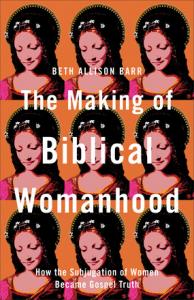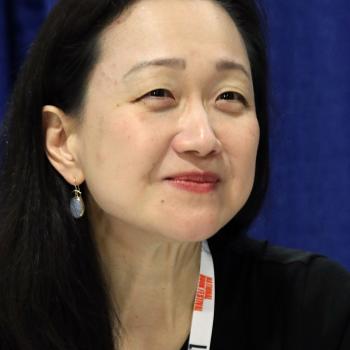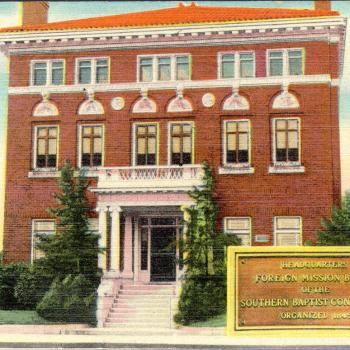It’s Beth Allison Barr week at The Anxious Bench, and for good reason. The Making of Biblical Womanhood went out into the world this week. Or, more like it, took on the world this week.
“Go, be free!” That’s how Beth ends her impassioned, historically informed demolition of complementarianism and the modern evangelical ideal of “biblical womanhood.”
There are so many things that I love about this book, so I’m going to gush about it for a while. First, it has a hefty, huge, simple thesis. “It is time for Christian patriarchy to end.” That’s on the back cover. “Complementarianism is patriarchy,” Beth argues, “and patriarchy is about power. Neither have ever been about Jesus.”
It might be a hit-you-over-the-head thesis, but this is not a simple book. Start reading, and there’s exegesis of Genesis 3 and the Pauline epistles. Most strikingly, though, there are stories of women, most commonly in the “Middle Ages” but also in all ages, who preached the gospel and publicly dedicated themselves to Jesus Christ in striking ways.
Let’s dig into some of these passages and examples. For starters, Genesis portrays male rule over women as a curse, as punishment for transgression, not as the natural, divinely ordained order of things. Then there is Mary Magdalene, who according to the Gospel of John is the first to testify to the resurrection. And what about the women Paul references in his letters, such as Junia (that’s a story in and of itself), one of those “outstanding among the apostles.”
What about “I do not permit a woman to teach or to have authority over a man?” Or “women should remain silent in the churches?” “Paul is not limiting women’s leadership,” Beth concludes, “he tells us with his own hand that women lead in the early church and that he supports their ministries.” Protestant Christians in general, and American evangelicals in particular, have placed far too much weight on these passages and frequently have also misread them. Beth makes a very strong case that although New Testament writings sometimes echo the patriarchy of the Roman world in which they were written, they frequently critique elements of that patriarchy. What do we want to do with that material? Reinforce patriarchy? Or overturn it?
I teach a course on the Global History of Christianity, and I won’t teach it the same way after reading this book. In past semesters, I’ve mentioned St. Jerome and his translation of the scriptures into Latin. I’ve never mentioned St. Paula, who after the death of her husband left her three children, founded a monastery in Bethlehem, and played a key role in the above-mentioned translation. From Mary Magdalene to Dorothy Sayers to Beth Moore, Beth highlights zealous disciples of Jesus Christ and who rejected any barriers men placed in their way.
If this book were only about the historical and biblical arguments, it would be outstanding. But what makes The Making of Biblical Womanhood even more compelling is the way Beth weaves her own story into her analysis. Because this isn’t just an academic argument. This history matters because it has shaped the conditions under which many Christians – women and men – live.
Beth’s husband lost his job as a youth pastor – after fourteen years in a church – because he and she rejected complementarianism. But that was just the last indignity. The church wouldn’t allow Beth to teach Sunday school classes that included teenage boys. “I led discussions with special permission when no one else was available,” she writes. And complementarianism and patriarchy affected interactions outside of the church as well. One of her college students suggested that she “clear” her teaching material with her husband before presenting it to the class. And there’s an extremely painful episode in which a boyfriend invites her to a Bill Gothard seminar, and she feels compelled to remain in the relationship after the boyfriend becomes abusive.
So let me get personal too, if not in such a compelling and raw fashion. When I was young, I took for granted that men should lead in churches (not so much in families, as my mom was the obvious spiritual leader in my family). I think I was in college before I met an ordained woman, and by then I had absorbed the complementarianism that Beth describes. It wasn’t that I was gung-ho in favor of complementarianism, but, as she suggests in The Making of Biblical Womanhood, I knew that it was the more liberal or progressive elements of American Protestantism that both ordained women and questioned many of the traditional doctrines of Christianity. So I was at least suspicious of egalitarianism purely on that basis. And those denominations that did ordain women were hemorrhaging members.
I changed my mind through my theological education and by getting to know women in various forms of ministry. At the same time, I didn’t exactly repent of my prior views or become a vocal advocate egalitarianism in homes and churches. I treated complementarianism like a “second-order” issue, and when people say that, it’s a way of saying “not that important.”
Here’s the rub. I’ve never had the experiences Beth has endured. I’ve never had a student suggest I check with my spouse while preparing lessons. No one’s ever objected when I’ve taught classes that included men and women. My spouse hasn’t lost her job because I believed I was equally capable of serving Jesus in any capacity which matched my talents. I’ve certainly never felt any pressure to remain in an abusive relationship.
That’s the power in this book. Complementarianism, even in its softer forms, isn’t just wrong, theologically and biblically. It’s a heresy that hurts people, practically, emotionally, and spiritually. So, as Beth says, “stop it!”











